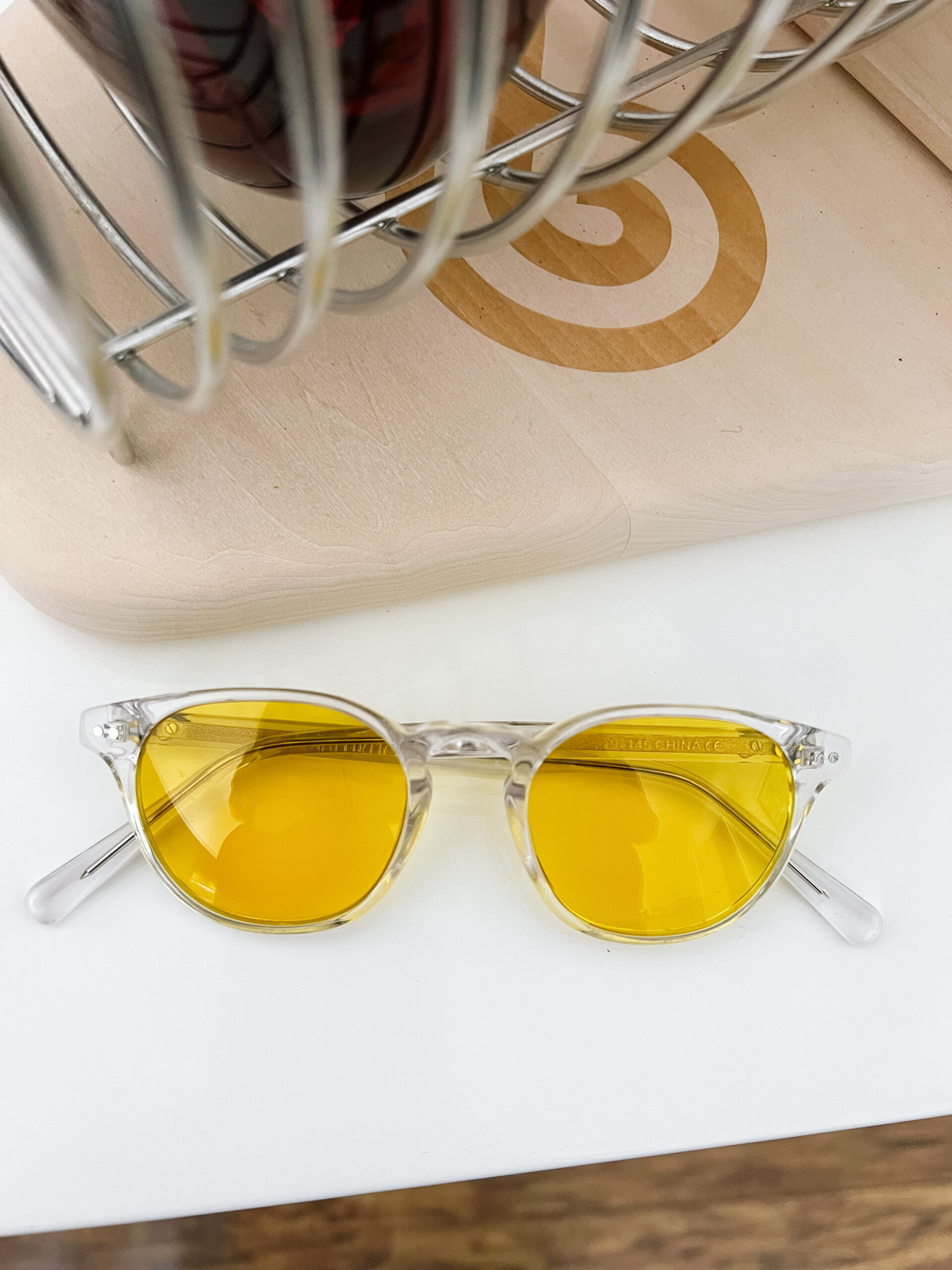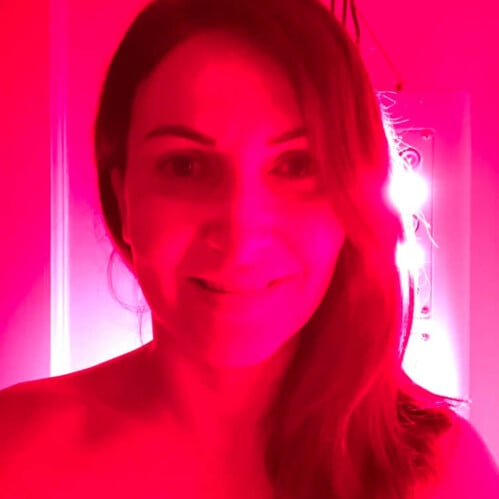I’m sharing a full review of Ra Optics blue light glasses and why they are essential to my evening routine and overall wellbeing.
Wearing blue light-blocking glasses has gained popularity in recent years due to concerns about the potential adverse effects of blue light exposure from screens and artificial lighting.
As we venture further into the digital era, the issue of screen time and its effect on our health becomes increasingly relevant. One particular concern is our exposure to blue light, which emanates not only from the sun but also from digital devices like computers, smartphones and televisions. Overexposure to blue light, especially in the evening, can disrupt our sleep patterns and potentially harm our eyes.
Understanding Blue Light
Blue light is part of the visible light spectrum. It has a shorter wavelength, meaning it produces higher amounts of energy. Studies suggest that overexposure to blue light can lead to eye strain and can interfere with our natural sleep cycle, known as the circadian rhythm. This is because blue light can suppress the production of melatonin, a hormone that regulates our sleep [1].
Blue light also emits from LED lighting. LED technology has become increasingly popular due to its energy efficiency and long lifespan. However, the blue light emitted by LEDs can cause similar issues as the blue light from screens. To reduce these potential risks, opt for warmer-colored LEDs. In our house, we hardly use the overhead LED lighting. We use lamps with softer bulbs, especially in the evenings.
Blue Light from the Sun vs. Blue Light from Devices
Blue light from the sun and blue light emitted by devices and lighting differ in several ways.
Firstly, the intensity of blue light from the sun is significantly higher than that emitted by devices. The sun is the primary source of blue light, and its emission is a natural phenomenon. In contrast, device-generated blue light is artificial and typically produced by LED screens.
Secondly, the timing of exposure differs. Sunlight provides blue light during daylight hours, which is beneficial for regulating the body’s circadian rhythm. On the other hand, device and lighting usage often extends into the evening and night, disrupting the natural sleep-wake cycle due to prolonged exposure to blue light.
Lastly, the wavelength composition may vary slightly. While both sources emit blue light in the 400-500 nanometer range, devices tend to emit a narrower spectrum with higher peaks, potentially increasing the risk of eye strain and other vision-related issues.
1: Blue Light Blocking Glasses Improve Sleep Quality
One of the primary benefits of wearing blue light-blocking glasses in the evening is the potential improvement in sleep quality. By filtering out blue light in the evening, these glasses can help maintain the natural production of melatonin.
A study published in the Journal of Psychiatric Research found that participants who wore blue light-blocking glasses a few hours before sleep experienced better sleep quality. The glasses were noted to increase the levels of melatonin, improving the overall sleep-wake cycle [2].
Another study from the Journal of Adolescent Health reported that adolescents wearing these glasses before sleep had significantly improved sleep quality and mood [3].
When I am consistent in wearing blue light glasses in the evening, I notice that my sleep is greatly improved and I go to bed much earlier. Blocking the blue light from your eyes, allows your body to produce melatonin more efficiently, so you can actually feel sleepy at bedtime.
By consistently wearing blue light glasses, we can reduce exposure to blue light in the evening, supporting a more restful night’s sleep.
2: Blue Light Blocking Glasses Reduce Eye Strain
An advantage of wearing blue light glasses in the evening is reduced eye strain. Overexposure to blue light can lead to symptoms like dry eyes, headaches, blurred vision, and fatigue, a condition often referred to as digital eye strain or computer vision syndrome [4].
By wearing blue light-blocking glasses, users can potentially reduce the risk of these symptoms. A study in the journal “Ophthalmic & Physiological Optics” found that those wearing blue light glasses reported fewer signs of eye strain [5].
I wear a pair that have a more yellow than red tint during the day. This makes it a little easier to see the screen while I am working.
3: Potential Long-Term Eye Health
While research is ongoing, some studies have indicated a potential link between prolonged exposure to blue light and age-related macular degeneration, a condition that can lead to vision loss over time. It is thought that the high-energy blue light may contribute to the gradual damage of cells in the retina [6].
While more research is needed, wearing blue light glasses in the evening may help mitigate potential long-term risks to eye health, especially for individuals at higher risk of eye conditions.
Embracing a Balanced Approach
While the benefits of blue light glasses are clear, they should be part of a balanced approach to screen use. Experts recommend practicing good screen hygiene, like following the 20-20-20 rule (every 20 minutes, look at something 20 feet away for 20 seconds), reducing screen time before bed, and using device settings to reduce blue light emission.
It’s important to remember that blue light in itself is not bad. Natural exposure from the sun during the day can boost alertness and mood [7]. However, our modern lifestyles have shifted the balance, and blue light-blocking glasses can be a helpful tool to redress this, especially in the evening.
As we continue to navigate the digital era, these glasses are becoming an increasingly popular option for those wishing to protect their eyes and improve their sleep.
There are a ton of blue light-blocking glasses on the market these days, but not all of them are equal when it comes to quality and performance. Today I’m sharing what blue light-blocking glasses are, why they are a staple in my routine, and why Ra Optics is my trusted brand of choice.
What are Blue Light-Blocking Glasses?
Blue light-blocking glasses have lenses that are intended to block or filter out the blue light given off from digital screens, like our computers and phones.
Blue light, also known as high-energy visible (HEV) light, is a color in the visible light spectrum that can be seen by human eyes. Unlike other forms of light, the eyes cannot effectively filter blue light, so more can pass through the eye to the retina.
Some resources say that prolonged exposure to blue light might be associated with eye strain, headaches, and quality of sleep.
How Ra Optics Lenses Work
Ra Optics lenses are my favorite option on the market and here is why! They are infused with a scientifically proven, proprietary mix of pigments that give the Day Lenses their signature yellow tint and Night Lenses their red tint.
The Day Lenses are designed to block 95% of the most damaging range of artificial blue light, whilst allowing the beneficial colors needed for perception, functionality, and health to pass through.
The Night Lenses block 100% of the artificial blue and green light up to the highest level shown to be harmful to your health and disrupting to your sleep patterns and circadian rhythm.
If you have a prescription, you can add them to your Ra Optics lenses!
Superior Quality & Color Perception
Ra Optics’ “lenses are CR-39, which is the highest-quality polymer available. Not only are they lightweight, scratch-proof, and shatter-resistant they are infused with a proprietary pigment that mimics the natural melanin found in our eyes. This infusion technique is unique to our lenses, making them the most effective Blue Light blocking glasses that won’t diminish your perception of the true color. We are proud to claim that no other blue light glasses on the market are able to match our level of protection with this degree of clarity.” source
Quality Frames
Ra Optics uses an exceptional Italian-made acetate, derived from renewable resources, for their frames. The frames are lightweight, durable, less harmful to the environment and far superior to cheap quality, petroleum-based plastic frames most glasses are made of. Plus, not only are they comfortable, they’re cute too!
Ra Optics Blue Light Blockers
I wear both the day and night glasses in the Clyde style.
- Clyde Daylight: Wear Daylight Lenses to block harmful blue light from fluorescent bulbs, LED’s, and screens during the day, whether at school, at work, or at home.
- Clyde Sunset: Wear Sunset Lenses from sunset to sleep to block sleep-disrupting blue light, re-align your body’s rhythm with nature, and get the best sleep of your life.
Ra Optics offers blue light blockers for kids, too.
Shop Ra Optics
Do you wear blue light-blocking glasses?
SHOP RA OPTICS
*Please note that this article is for informational purposes only and is not medical advice.
References
- Gooley, J. J., et al. (2011). Exposure to Room Light before Bedtime Suppresses Melatonin Onset and Shortens Melatonin Duration in Humans. Journal of Clinical Endocrinology & Metabolism, 96(3), E463–E472.
- Shechter, A., et al. (2018). Blocking nocturnal blue light for insomnia: A randomized controlled trial. Journal of Psychiatric Research, 96, 196–202.
- Hysing, M., et al. (2015). Sleep and use of electronic devices in adolescence: results from a large population-based study. BMJ Open, 5(1), e006748.
- American Optometric Association. Computer Vision Syndrome.
- Rosenfield, M. (2016). Computer vision syndrome (a.k.a. digital eye strain). Ophthalmic & Physiological Optics. 36(2), 77-83.
- Lawrenson, J. G., et al. (2017). The effect of blue-light blocking spectacle lenses on visual performance, macular health and the sleep-wake cycle: a systematic review of the literature. Ophthalmic & Physiological Optics, 37(6), 644–654.
- Lockley, S. W., et al. (2003). High Sensitivity of the Human Circadian Melatonin Rhythm to Resetting by Short Wavelength Light. The Journal of Clinical Endocrinology & Metabolism, 88(9), 4502–4505.
You may also enjoy:
Disclaimer: This post contains affiliate links. All opinions are my own.








